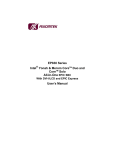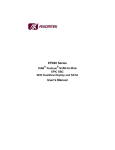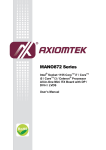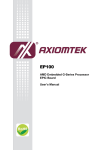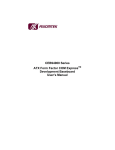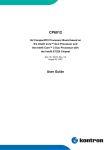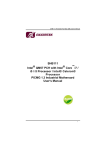Download PDF - Daisy Data Displays
Transcript
SBC84831 Series ® Intel Atom™ Processor N270 Capa Board with LVDS User’s Manual Disclaimers This manual has been carefully checked and believed to contain accurate information. AXIOMTEK Co., Ltd. assumes no responsibility for any infringements of patents or any third party’s rights, and any liability arising from such use. AXIOMTEK does not warrant or assume any legal liability or responsibility for the accuracy, completeness or usefulness of any information in this document. AXIOMTEK does not make any commitment to update the information in this manual. AXIOMTEK reserves the right to change or revise this document and/or product at any time without notice. No part of this document may be reproduced, stored in a retrieval system, or transmitted, in any form or by any means, electronic, mechanical, photocopying, recording, or otherwise, without the prior written permission of AXIOMTEK Co., Ltd. Caution If you replace wrong batteries, it causes the danger of explosion. It is recommended by the manufacturer that you follow the manufacturer’s instructions to only replace the same or equivalent type of battery, and dispose of used ones. ©Copyright 2009 AXIOMTEK Co., Ltd. All Rights Reserved February 2009, Version A1 Printed in Taiwan ii ESD Precautions Computer boards have integrated circuits sensitive to static electricity. To prevent chipsets from electrostatic discharge damage, please take care of the following jobs with precautions: Do not remove boards or integrated circuits from their anti-static packaging until you are ready to install them. Before holding the board or integrated circuit, touch an unpainted portion of the system unit chassis for a few seconds. It discharges static electricity from your body. Wear a wrist-grounding strap, available from most electronic component stores, when handling boards and components. Trademarks Acknowledgments AXIOMTEK is a trademark of AXIOMTEK Co., Ltd. ® Windows is a trademark of Microsoft Corporation. ® AMI is a registered trademark of American Megatrends Inc. IBM, PC/AT, PS/2, VGA are trademarks of International Business Machines Corporation. ® Intel and Atom™ are trademarks of Intel Corporation. Winbond is a trademark of Winbond Electronics Corp. Other brand names and trademarks are the properties and registered brands of their respective owners. iii Table of Contents Disclaimers ........................................................................................................... ii ESD Precautions ................................................................................................. iii CHAPTER 1 INTRODUCTION ..................................................................................... 1 1.1 Specifications .......................................................................................... 2 1.2 Utilities Supported ................................................................................... 3 CHAPTER 2 JUMPERS AND CONNECTORS............................................................ 5 2.1 Board Dimensions and Fixing Holes ....................................................... 5 2.2 Board Layout ........................................................................................... 7 2.3 Jumper Settings ...................................................................................... 9 2.3.1 LCD Voltage Selection Jumper (JP1)............................................. 10 2.3.2 Audio Output Jumper (JP2)............................................................ 10 2.3.3 Auto Power On Jumper (JP3) ........................................................ 11 2.3.4 CompactFlash™ Voltage Jumper (JP4)......................................... 11 2.3.5 CMOS Clear Jumper (JP5) ............................................................ 12 2.3.6 COM5 Mode Selection Jumper (JP6)............................................. 12 2.3.7 COM6 Mode Selection Jumper (JP7)............................................. 13 2.3.8 COM3 Mode Selection Jumper (JP8)............................................. 14 2.3.9 COM4 Mode Selection Jumper (JP9)............................................. 15 2.3.10 COM1 Mode Selection Jumper (JP10)........................................... 16 2.3.11 COM2 Mode Selection Jumper (JP11)........................................... 17 2.4 Connectors ............................................................................................ 18 2.4.1 ATX 4 Pin 12V Connector (ATX1).................................................. 19 2.4.2 LVDS Backlight Connector (CN1) .................................................. 19 2.4.3 Audio Phone Jack Connector (CN2) .............................................. 19 2.4.4 LVDS Flat Panel Connector (CN3)................................................. 20 2.4.5 Flat Panel Bezel Connector (CN4) ................................................. 21 2.4.6 Digital I/O Port Connector (CN5).................................................... 22 2.4.7 Serial Port5 & Serial Port6 (CN6)................................................... 23 2.4.8 SMBus Connector (CN7)................................................................ 23 2.4.9 Keyboard and PS/2 Mouse Connector (CN8) ................................ 24 2.4.10 VGA Connector (CN9).................................................................... 24 2.4.11 Serial Port1 Connector (COM1) ..................................................... 25 2.4.12 Serial Port 2, 3, 4 Connectors (COM2, COM3, COM4).................. 25 2.4.13 Power output Connector (CN10) .................................................... 26 2.4.14 Ethernet Connectors (LAN1, LAN2) ............................................... 26 2.4.15 SATA Connectors (SATA1, SATA2) .............................................. 26 2.4.16 USB Port Connector (USB2) .......................................................... 27 2.4.17 Internal USB Connector (USB1)..................................................... 27 2.4.18 CompactFlash™ Socket (SCF1) .................................................... 28 CHAPTER 3 HARDWARE DESCRIPTION................................................................ 29 3.1 Microprocessors .................................................................................... 29 3.2 BIOS...................................................................................................... 29 3.3 System Memory..................................................................................... 29 3.4 I/O Port Address Map............................................................................ 30 iv 3.4 3.5 I/O Port Address Map............................................................................ 30 Interrupt Controller ................................................................................ 31 CHAPTER 4 AMI BIOS SETUP UTILITY................................................................... 33 4.1 Starting .................................................................................................. 33 4.2 Navigation Keys .................................................................................... 33 4.3 Main Menu............................................................................................. 34 4.4 Advanced Menu .................................................................................... 35 4.5 PCI PnP Menu....................................................................................... 53 4.6 Boot Menu ............................................................................................. 56 4.7 Security Menu ....................................................................................... 60 4.8 Chipset Menu ........................................................................................ 62 4.9 Exit Menu .............................................................................................. 67 APPENDIX A WATCHDOG TIMER ........................................................................... 69 APPENDIX B DIGITAL I/O......................................................................................... 71 v MEMO vi SBC84831 All-In-One Capa Board User’s Manual CHAPTER 1 INTRODUCTION ® The SBC84831, a Capa board, supports Intel Atom™ processor ® N270, at FSB 533 MHz. The board integrates chipsets Intel 945GSE and ICH7M that deliver outstanding system performance through high-bandwidth interfaces, multiple I/O functions for interactive applications and various embedded computing solutions. There is one 200-pin unbuffered SO-DIMM sockets for singe channel DDR2400/533 MHz memory, maximum memory capacity up to 1GB. It also features two Gigabit/Fast Ethernet, two serial ATA channels for total two Serial ATA hard drives at maximum transfer rate up to 150MB/sec, four USB 2.0 high speed compliant, built-in AC’97 audio codec that can achieve the best stability and reliability for industrial applications. Additionally, it provides you with unique embedded features, such as 6 serial ports and 3.5” form factor that applies an extensive array of PC peripherals. Introduction 1 SBC84831 All-In-One Capa Board User’s Manual 1.1 Specifications CPU z ® Intel Atom TM processor N270 System Chipset ® Intel 945GSE & ICH7M z z Front-Side Bus 533 MHz z BIOS American Megatrends Inc. BIOS. 8Mbit SPI Flash, DMI, Plug and Play “Load Optimized Default” to backup customized Setting in the BIOS flash chip to prevent from CMOS battery fail System Memory One 200-pin unbuffered DDR2 SO-DIMM sockets Maximum to 1GB DDR2 400/533 MHz memory z z Onboard Multi I/O Controller: Winbond W83627UHG Serial Ports: Six ports for RS-232 Two SATA-150 connectors z CompactFlash™ Socket One CompactFlash™ Type II Socket USB Interface Four USB ports with fuse protection and complies with USB Spec. Rev. 2.0 z Display CRT connector One 40-pin connector for 24-bit dual channel LVDS via Chrontel CH7308B from SDVO as EFP port and one 7-pin inverter connector(Optional) z 2 Introduction SBC84831 All-In-One Capa Board User’s Manual z Watchdog Timer 1~255 seconds; up to 255 levels z Ethernet Dual port with RTL8111B for Gigabit/Fast Ethernet z z Audio AC’97 Audio compliant (with Speaker/line-out & MIC-in) via ALC203 Internal Audio features for speaker-out & MIC-in & Line-in via Box Header connector Power Management ACPI (Advanced Configuration and Power Interface) z Form Factor 3.5” form factor NOTE All specifications and images are subject to change without notice. 1.2 z z z z Utilities Supported Chipset Driver Ethernet Driver Graphic Driver Audio Driver Introduction 3 SBC84831 All-In-One Capa Board User’s Manual MEMO 4 Introduction SBC84831 All-In-One Capa Board User’s Manual CHAPTER 2 JUMPERS AND CONNECTORS CN3 134.16 137.16 124.86 104.10 82.30 60.50 0.00 JP1 CN2 101.47 95.26 27.81 Board Dimensions and Fixing Holes 8.89 2.1 CN1 101.47 JP2 95.26 81.29 CN4 ATX1 69.60 U5 66.55 U7 SATA1 57.90 SATA2 42.32 JP3 JP5 33.02 U15 CN5 JP4 CN6 G USB1 CN10 1 G +12V JP8 JP9 23.72 4 +5V COM4 JP6 JP7 JP10 JP11 CN7 0.00 3.18 0.00 3.18 COM3 134.16 137.16 115.11 CN9 103.76 91.11 LAN1 CN8 82.66 LAN2 75.40 USB2 59.69 18.77 0.00 8.89 COM1 43.14 COM2 Component Side Jumpers and Connectors 5 SBC84831 All-In-One Capa Board User’s Manual 146.05 70.05 46.53 SCN1 26.54 SCF1 104.65 73.28 32.66 14.73 47.50 1.90 Solder Side 6 Jumpers and Connectors Jumpers and Connectors JP10 JP11 JP8 JP9 JP6 JP7 CN5 JP4 SATA2 SATA1 COM2 COM1 COM4 JP5 COM3 CN6 U7 JP1 USB2 LAN2 JP3 CN3 CN8 USB1 U5 LAN1 CN1 U15 CN9 CN7 CN10 ATX1 2.2 CN4 JP2 CN2 SBC84831 All-In-One Capa Board User’s Manual Board Layout Component Side 7 SCN1 SCF1 SBC84831 All-In-One Capa Board User’s Manual Solder Side 8 Jumpers and Connectors SBC84831 All-In-One Capa Board User’s Manual 2.3 Jumper Settings Proper jumer settings configure the SBC84831 to meet your application purpose. We are herewith listing a summary table of all jumpers and default settings for onboard devices, respectively. Jumper Default Setting Jumper Setting JP1 LVDS Voltage Selection Default: 3.3V Short 1-2 JP2 Audio Speak Out/Line Out Selection Default: Line Out Short 1-3, 2-4 JP3 Auto Power ON Default: Disable Short JP4 Compact Flash Voltage Selection Default: 3.3V Short 1-2 JP5 Normal Operation/Clear CMOS setting Default: Normal Operation Short 1-2 JP6 COM5 Mode Select JP7 COM6 Mode Select JP8 COM3 Mode Select CN6 Pin 1: DCD CN6 Pin 8: RI CN6 Pin 11: DCD CN6 Pin 18: RI COM3 Pin 1: DCD COM3 Pin 8: RI Short 3-5 Short 4-6 Short 3-5 Short 4-6 Short 3-5 Short 4-6 JP9 COM4 Mode Select COM4 Pin 1: DCD COM4 Pin 8: RI Short 3-5 JP10 COM1 Mode Select COM1 Pin 1: DCD COM1 Pin 9: RI Short 3-5 JP11 COM2 Mode Select COM1 Pin 1: DCD COM1 Pin 8: RI Short 3-5 Jumpers and Connectors Short 4-6 Short 4-6 Short 4-6 9 SBC84831 All-In-One Capa Board User’s Manual 2.3.1 LCD Voltage Selection Jumper (JP1) The board supports +3.3V or +5V flat panel displays. Configure the jumper JP1 to the appropriate voltage of the flat panel. Description Function Jumper Setting LCD Voltage 3.3V Selection (Default) 5V 2.3.2 Audio Output Jumper (JP2) This jumper is to select the Audio output. Description Function Jumper Setting Audio Output Line Out (Default) Speaker Out 10 Jumpers and Connectors SBC84831 All-In-One Capa Board User’s Manual 2.3.3 Auto Power On Jumper (JP3) When Jumper JP3 is set OPEN for AC power input, the system will be automatically power ON without pressing soft power button; when JP3 is SHORT for AC power input, it is necessary to manually press soft power button to make the system power ON. Note This function is similar to the feature of Power On after Power Failed, which is controlled by hardware circuitry instead of BIOS. Description Auto Power On Function Jumper Setting Disable (Default) Enable 2.3.4 CompactFlash™ Voltage Jumper (JP4) The jumper is to select the voltage for CompactFlash™ interface. Description Function Jumper Setting Compact Flash 3.3V Voltage (Default) Selection 5V Jumpers and Connectors 11 SBC84831 All-In-One Capa Board User’s Manual 2.3.5 CMOS Clear Jumper (JP5) You may need to use this jumper is to clear the CMOS memory if incorrect settings in the Setup Utility. Description Function Jumper Setting CMOS Clear Normal (Default) Clear CMOS 2.3.6 COM5 Mode Selection Jumper (JP6) The jumper selects the CN6 COM5 ports’ DCD and RI mode. Description COM5 Function Jumper Setting CN6 Pin 1=5V CN6 Pin 1=DCD (Default) CN6 Pin 8=12V CN6 Pin 8=RI (Default) 12 Jumpers and Connectors SBC84831 All-In-One Capa Board User’s Manual 2.3.7 COM6 Mode Selection Jumper (JP7) The jumper selects the CN6 COM6 ports’ DCD and RI mode. Description COM6 Function Jumper Setting CN6 Pin 11=5V CN6 Pin 11=DCD (Default) CN6 Pin 18=12V CN6 Pin 18=RI (Default) Jumpers and Connectors 13 SBC84831 All-In-One Capa Board User’s Manual 2.3.8 COM3 Mode Selection Jumper (JP8) The jumper selects the COM3 ports’ DCD and RI mode. Description COM3 Function Jumper Setting Pin 1=5V Pin 1=DCD (Default) Pin 8=12V Pin 8=RI (Default) 14 Jumpers and Connectors SBC84831 All-In-One Capa Board User’s Manual 2.3.9 COM4 Mode Selection Jumper (JP9) The jumper selects the COM4 ports’ DCD and RI mode. Description COM4 Function Jumper Setting Pin 1=5V Pin 1=DCD (Default) Pin 8=12V Pin 8=RI (Default) Jumpers and Connectors 15 SBC84831 All-In-One Capa Board User’s Manual 2.3.10 COM1 Mode Selection Jumper (JP10) The jumper selects the COM1 ports’ DCD and RI mode. Description COM1 Function Jumper Setting Pin 1=5V Pin 1=DCD (Default) Pin 9=12V Pin 9=RI (Default) 16 Jumpers and Connectors SBC84831 All-In-One Capa Board User’s Manual 2.3.11 COM2 Mode Selection Jumper (JP11) The jumper selects the COM2 ports’ DCD and RI mode. Description COM2 Function Jumper Setting Pin 1=5V Pin 1=DCD (Default) Pin 8=12V Pin 8=RI (Default) Jumpers and Connectors 17 SBC84831 All-In-One Capa Board User’s Manual 2.4 Connectors Connectors connect the board with other parts of the system. Loose or improper connection might cause problems. Make sure all connectors are properly and firmly connected. Here is a summary table shows you all connectors on the SBC84831 Series. Connector Label Connector Label ATX 4 Pin 12V In ATX1 Power output Connector CN10 LVDS Backlight Connector CN1 Ethernet1 Connector LAN1 Audio Connector CN2 Ethernet2 Connector LAN2 LVDS Connector CN3 SATA1 Connector SATA1 Front Panel Connector CN4 SATA2 Connector SATA2 2*5pin DIO Connector CN5 USB2, USB3 Connector USB1 COM5, COM6 Connector CN6 USB0, USB1 Connector USB2 SMBus Connector CN7 CF Connector SCF1 PS/2 Connector CN8 DDRII SO-DIMM Connector SCN1 VGA Connector CN9 COM1 Connector COM1 COM2 Connector COM2 COM3 Connector COM3 COM4 Connector COM4 18 Jumpers and Connectors SBC84831 All-In-One Capa Board User’s Manual 2.4.1 ATX 4 Pin 12V Connector (ATX1) Connect it to the power supply ATX12V power. Pin Signal 1 GND 2 GND 3 +12V 4 +12V 2 1 2.4.2 LVDS Backlight Connector (CN1) The CN1 is DF13-7S-1.25C 7-pin connectors for inverter that we strongly recommend you to use the matching DF13-7S-1.25C connector. Pin Signal 1 +12V 2 +12V 3 +5V 4 ENABLE 5 GND 6 GND 7 GND 2.4.3 Audio Phone Jack Connector (CN2) Pin Signal Pin Signal 1 MIC_IN 2 Ground (GND) 3 LINE_IN_L 4 Ground (GND) 5 LINE_IN_R 6 Ground (GND) 7 AUDIO_OUT_L 8 Ground (GND) 9 AUDIO_OUT_R 10 Ground (GND) Jumpers and Connectors 19 SBC84831 All-In-One Capa Board User’s Manual 2.4.4 LVDS Flat Panel Connector (CN3) The board has a 40-pin connector CN3 for LVDS Interface LCD. It is strongly recommended to use the matching GLA1001WV-S-2x20P 40pin connector for LVDS on the board. Pin Signal Pin Signal 1 3 5 7 VCCM VCCM VCCM N.C. 2 4 6 8 VCCM VCCM VCCM N.C. 9 GND Channel B D3- (24-Bit support) 10 GND 12 Channel B D0- 11 13 Channel B D3+ (24-Bit support) 14 Channel B D0+ 15 17 19 21 23 25 27 GND Channel B CLKChannel B CLK+ GND Channel A D0Channel A D0+ GND 16 18 20 22 24 26 28 29 Channel A D1- 30 GND Channel B D1Channel B D1+ GND Channel B D2Channel B D2+ GND Channel A D3- (24-Bit support) 31 Channel A D1+ 32 Channel A D3+ (24-Bit support) 33 35 37 39 GND Channel A D2Channel A D2+ GND 34 36 38 40 GND Channel A CLKChannel A CLK+ GND 20 Jumpers and Connectors SBC84831 All-In-One Capa Board User’s Manual CN3 2.4.5 Flat Panel Bezel Connector (CN4) Power LED This 3-pin connector has Pin 1 and Pin 5 that connect the system power LED indicator to its corresponding switch on the case. Pin 1 is assigned as +, and Pin 3, Pin 5 as -. The Power LED lights up when the system is powered ON. Pin 3 is defined as GND External Speaker and Internal Buzzer Connector Pin 2, 4, 6 and 8 can be connected to the case-mounted speaker unit or internal buzzer. While connecting the CPU card to an internal buzzer, please short pins 2-4; while connecting to an external speaker, you need to set pins 2-4 to Open and connect the speaker cable to pin 8 (+) and pin 6 (-). ATX Power On/Off Button This 2-pin connector named as Pin 9 and 10 connect the front Jumpers and Connectors 21 SBC84831 All-In-One Capa Board User’s Manual panel’s ATX power button to the CPU card, which allows users to control ATX power supply to be power on/off. System Reset Switch Pin 11 and 12 can be connected to the case-mounted reset switch that reboots your computer, not turns OFF the power switch. It is a better way to reboot your system for a longer life of the system’s power supply. HDD Activity LED This connection is linked to hard drive activity LED on the control panel. LED flashes when HDD is being accessed. Pin 13 and 14 connect the hard disk drive to the front panel HDD LED, Pin 13 assigned as -, and Pin 14 as +. 2.4.6 Digital I/O Port Connector (CN5) The board is equipped an 8-channel (3in, 5out) digital I/O connector that meets requirements for a system customary automation control. The digital I/O can be configured to control cash drawers and sense warning signals from an Uninterrupted Power System (UPS), or perform store security control. The digital I/O is controlled via software programming. Pin 22 Signal Pin Signal 1 Digital Input 0 2 Digital Output 0 3 Digital Input 1 4 Digital Output 1 5 Digital Input 2 6 Digital Output 2 7 Ground (GND) 8 Digital Output 3 9 Ground (GND) 10 Digital Output 4 Jumpers and Connectors SBC84831 All-In-One Capa Board User’s Manual 2.4.7 Serial Port5 & Serial Port6 (CN6) Pin Signal Pin Signal 1 DCD5 2 DSR5 3 RXD5 4 RTS5 5 TXD5 6 CTS5 7 DTR5 8 RI5 9 GND 10 N.C. 11 DCD6 12 DSR6 13 RXD6 14 RTS6 15 TXD6 16 CTS6 17 DTR6 18 RI6 19 GND 20 N.C. 2.4.8 SMBus Connector (CN7) Connector CN7 is for SMBUS interface support. Pin Signal 1 CLOCK 2 DATA 3 GND Jumpers and Connectors 23 SBC84831 All-In-One Capa Board User’s Manual 2.4.9 Keyboard and PS/2 Mouse Connector (CN8) The board supports a keyboard and Mouse interface. Connector is a DIN connector for PS/2 keyboard Connection VIA “Y” Cable. Pin Signal 1 Keyboard Data 2 Mouse Data 3 GND 4 VCC 5 Keyboard Clock 6 Mouse Clock 2.4.10 VGA Connector (CN9) The board has three connectors to support CRT VGA and flat panel displays, individually or simultaneously. Connector is a slim type 15-pin D-Sub connector commonly for the CRT VGA display. The VGA interface configuration is done via the software utility, and no jumper setting is required. Pin Signal Pin Signal Pin Signal 1 4 7 10 13 Red N.C. GND GND Horizontal Sync 2 5 8 11 14 Green GND GND N.C. Vertical Sync 3 6 9 12 15 Blue DETECT VCC DDC DATA DDC CLK 24 Jumpers and Connectors SBC84831 All-In-One Capa Board User’s Manual 2.4.11 Serial Port1 Connector (COM1) The COM 1 Port connector is a standard DB-9 connector. Pin Signal 1 DCD, Data carrier detect 2 RXD, Receive data 3 TXD, Transmit data 4 DTR, Data terminal ready 5 GND, ground 6 DSR, Data set ready 7 RTS, Request to send 8 CTS, Clear to send 9 RI, Ring indicator 2.4.12 Serial Port 2, 3, 4 Connectors (COM2, COM3, COM4) Here is the pin assignment list for your reference. Pin Signal Pin Signal 1 Data Carrier Detect (DCD) 2 Data Set Ready (DSR) 3 Receive Data (RXD) 4 Request to Send (RTS) 5 Transmit Data (TXD) 6 Clear to Send (CTS) 7 Data Terminal Ready (DTR) 8 Ring Indicator (RI) 9 Ground (GND) 10 N.C. Jumpers and Connectors 25 SBC84831 All-In-One Capa Board User’s Manual 2.4.13 Power output Connector (CN10) Pin Signal 1 2 3 4 +12V GND GND +5V 2.4.14 Ethernet Connectors (LAN1, LAN2) The RJ-45 connector is for Ethernet. To connect the board to a 1000/100/10 Base-T hub, just plug one end of the cable into connector and connect the other end (phone jack) to a 1000/100/10-Base-T hub. Pin Signal Pin Signal L1 MDI0+ L5 MDI2- L2 MDI0- L6 MDI1- L3 MDI1+ L7 MDI3+ L4 MDI2+ L8 MDI3- A Active LED (Yellow) B 100 LAN LED (Green)/ 1000 LAN LED (Orange) 2.4.15 SATA Connectors (SATA1, SATA2) These SATA connectors are for high-speed SATA interface ports and they can be connected to hard disk devices. Pin 1 26 Signal GND 2 SATA_TX+ 3 SATA_TX- 4 GND 5 SATA_RX- 6 SATA_RX+ 7 GND Jumpers and Connectors SBC84831 All-In-One Capa Board User’s Manual 2.4.16 USB Port Connector (USB2) Pin Signal Pin Signal 1 USB VCC0 (5VSBY) 5 USB VCC0 (5VSBY) 2 USB D0- 6 USB D1- 3 USB D0+ 7 USB D1+ 4 Ground (GND) 8 Ground (GND) 2.4.17 Internal USB Connector (USB1) These Universal Serial Bus (USB) connectors on this board are for installing versatile USB interface peripherals. This is a 10-pin standard USB connector. Pin 1 Signal Pin Signal 2 3 USB VCC1 (5VSBY) USB D2- 4 USB VCC1 (5VSBY) USB D3- 5 USB D2+ 6 USB D3+ 7 Ground (GND) 8 Ground (GND) 9 Ground (GND) 10 Ground (GND) Jumpers and Connectors 27 SBC84831 All-In-One Capa Board User’s Manual 2.4.18 CompactFlash™ Socket (SCF1) The board is equipped with a CompactFlashTM disk type-II socket on the solder side to support an IDE interface CompactFlashTM disk card with DMA mode supported. The socket is especially designed to avoid incorrect installation of the CompactFlashTM disk card. When installing or removing the CompactFlashTM disk card, please make sure the system power is off. The CompactFlashTM disk card is defaulted as the C: or D: disk drive in your PC system. Pin 28 Signal Pin Signal 1 GND 26 N.C. 2 Data 3 27 Data 11 3 Data 4 28 Data 12 4 Data 5 29 Data 13 5 Data 6 30 Data 14 6 Data 7 31 Data 15 7 CS0# 32 CS1# 8 GND 33 N.C. 9 ATASEL 34 IORD# 10 GND 35 IOWR# 11 GND 36 WE# 12 GND 37 INTR 13 CF_VCC 38 CF_VCC 14 GND 39 CSEL# 15 GND 40 N.C. 16 GND 41 RESET# 17 GND 42 IORDY# 18 Address 2 43 DMAREQ 19 Address 1 44 DMAACK- 20 Address 0 45 DASP# 21 Data 0 46 PDIAG# 22 Data 1 47 Data 8 23 Data 2 48 Data 9 24 N.C. 49 Data 10 25 GND 50 GND Jumpers and Connectors SBC84831 All-In-One Capa Board User’s Manual CHAPTER 3 HARDWARE DESCRIPTION 3.1 Microprocessors ® The SBC84831 Series supports Intel Atom™ processor N270, which make your system operated under Windows XP and Windows VISTA environments.The system performance depends on the microprocessor. Make sure all correct settings are arranged for your installed microprocessor to prevent the CPU from damages. 3.2 BIOS The SBC84831 Series uses AMI Plug and Play BIOS with a single 8Mbit SPI Flash, DMI, Plug and Play. 3.3 System Memory The SBC84831 Series industrial CPU card supports one 200-pin unbuffered DDR2 SO-DIMM sockets for a maximum memory of 1GB DDR2 SDRAMs. The memory module can come in sizes of 128MB, 256MB, 512MB and 1GB. Hardware Description 29 SBC84831 All-In-One Capa Board User’s Manual 3.4 I/O Port Address Map There are total 1KB port addresses (under OS WinXP) available for assignment to other devices via I/O expansion cards. 30 Hardware Description SBC84831 All-In-One Capa Board User’s Manual 3.5 Interrupt Controller The SBC84831 Series is a 100% PC compatible control board. It consists of 16 interrupt request lines, and four out of them can be programmable. The mapping list of the 16 interrupt request lines is shown as the following table. IRQ Parity check error IRQ0 System Timer Output IRQ1 Keyboard IRQ2 Interrupt rerouting from IRQ8 through IRQ15 IRQ3 Serial port #2 IRQ4 Serial port #1 IRQ5 PCI Device Share IRQ6 PCI Device Share IRQ7 PCI Device Share IRQ8 Real time clock IRQ9 ACPI Controller IRQ10 Serial port #4, Serial port #6 IRQ11 Serial port #3, Serial port #5 IRQ12 PS/2 Mouse IRQ13 Math coprocessor IRQ14 SATA Primary (Legacy Mode) IRQ15 SATA Secondary (Legacy Mode) Hardware Description 31 SBC84831 All-In-One Capa Board User’s Manual MEMO 32 Hardware Description SBC84831 All-In-One Capa Board User’s Manual CHAPTER 4 AMI BIOS SETUP UTILITY This chapter provides users with detailed description how to set up basic system configuration through the AMIBIOS8 BIOS setup utility. 4.1 Starting To enter the setup screens, follow the steps below: 1. 2. Turn on the computer and press the <Del> key immediately. After you press the <Delete> key, the main BIOS setup menu displays. You can access the other setup screens from the main BIOS setup menu, such as the Chipset and Power menus. 4.2 Navigation Keys The BIOS setup/utility uses a key-based navigation system called hot keys. Most of the BIOS setup utility hot keys can be used at any time during the setup navigation process. These keys include <F1>, <F10>, <Enter>, <ESC>, <Arrow> keys, and so on. Note Some of navigation keys differ from one screen to another. Å Left/Right The Left and Right <Arrow> keys allow you to select a setup screen. ÇÈ Up/Down The Up and Down <Arrow> keys allow you to select a setup screen or sub-screen. +− Plus/Minus The Plus and Minus <Arrow> keys allow you to change the field value of a particular setup item. Tab F1 The <Tab> key allows you to select setup fields. The <F1> key allows you to display the General Help screen. AMI BIOS Setup Utility 33 SBC84831 All-In-One Capa Board User’s Manual F10 The <F10> key allows you to save any changes you have made and exit Setup. Press the <F10> key to save your changes. Esc The <Esc> key allows you to discard any changes you have made and exit the Setup. Press the <Esc> key to exit the setup without saving your changes. Enter 4.3 The <Enter> key allows you to display or change the setup option listed for a particular setup item. The <Enter> key can also allow you to display the setup sub- screens. Main Menu When you first enter the Setup Utility, you will enter the Main setup screen. You can always return to the Main setup screen by selecting the Main tab. There are two Main Setup options. They are described in this section. The Main BIOS Setup screen is shown below. System Time/Date Use this option to change the system time and date. Highlight System Time or System Date using the <Arrow> keys. Enter new z 34 AMI BIOS Setup Utility SBC84831 All-In-One Capa Board User’s Manual values through the keyboard. Press the <Tab> key or the <Arrow> keys to move between fields. The date must be entered in MM/DD/YY format. The time is entered in HH:MM:SS format. 4.4 Advanced Menu The Advanced menu allows users to set configuration of the CPU and other system devices. You can select any of the items in the left frame of the screen to go to the sub menus: y y y y y y y y y CPU Configuration IDE Configuration SuperIO Configuration Hardware Health Configuration ACPI Configuration APM Configuration MPS Configuration PCI Express Configuration USB Configuration For items marked with “f”, please press <Enter> for more options. AMI BIOS Setup Utility 35 SBC84831 All-In-One Capa Board User’s Manual Configure advanced CPU settings This screen shows the CPU Configuration, and you can change the value of the selected option. z 36 ¾ Max CPUID Value Limit You can enable this item to let legacy operating systems boot even without support for CPUs with extended CPU ID functions. ¾ Execute-Disable Bit Capability This item helps you enable or disable the NoExecution Page Protection Technology. ¾ Hyper Threading Technology Use this item to enable or disable Hyper-Threading Technology, which makes a single physical processor perform multi-tasking function as two logical ones. ¾ Intel (R) SpeedStep (tm) tech This item helps you enable or disable the Intel SpeedStep Technology. ¾ Intel (R) C-STATE tech Use this item to enable or disable the C-State AMI BIOS Setup Utility SBC84831 All-In-One Capa Board User’s Manual technology. ¾ z Enhanced C-States This item allows you to enable or disable any available enhanced C-states ( C1E, C2E, C3E, C4E and Hard C4E). IDE Configuration You can use this screen to select options for the IDE Configuration, and change the value of the selected option. A description of the selected item appears on the right side of the screen. For items marked with “f”, please press <Enter> for more options. ¾ ATA/IDE Configuration Use this item to specify the integrated IDE controller. There are three options for your selection: Disabled, Compatible and Enhanced. ¾ Legacy IDE Channels When the ATA/IDE Configuration is set to Compatible, this item will be displayed. AMI BIOS Setup Utility 37 SBC84831 All-In-One Capa Board User’s Manual ¾ Primary/Secondary/Third IDE Master/Slave Select one of the hard disk drives to configure IDE devices installed in the system by pressing <Enter> for more options. SuperIO Configuration You can use this screen to select options for the SuperIO Configuration, and change the value of the selected option. A description of the selected item appears on the right side of the screen. z 38 ¾ Serial Port1 Address This item specifies the base I/O port address and Interrupt Request address of serial port 1. The Optimal setting is 3F8/IRQ4. The Fail-Safe default setting is Disabled. ¾ Serial Port1 IRQ This item specifies the IRQ used by the serial port 1. ¾ Serial Port2 Address This item specifies the base I/O port address and AMI BIOS Setup Utility SBC84831 All-In-One Capa Board User’s Manual Interrupt Request address of serial port 2. The Optimal setting is 2F8/IRQ3. The Fail-Safe setting is Disabled. ¾ Serial Port2 IRQ This item specifies the IRQ used by the serial port 2. ¾ Serial Port2 Mode This item specifies the mode used by the serial port 2. ¾ Serial Port3 Address This item specifies the base I/O port address and Interrupt Request address of serial port 3. ¾ Serial Port3 IRQ This item specifies the IRQ used by the serial port 3. ¾ Serial Port4 Address This item specifies the base I/O port address and Interrupt Request address of serial port 4. ¾ Serial Port4 IRQ This item specifies the IRQ used by the serial port 4. ¾ Serial Port5 Address This item specifies the base I/O port address and Interrupt Request address of serial port 5. ¾ Serial Port5 IRQ This item specifies the IRQ used by the serial port 5. ¾ Serial Port6 Address This item specifies the base I/O port address and Interrupt Request address of serial port 6. ¾ Serial Port6 IRQ This item specifies the IRQ used by the serial port 6. AMI BIOS Setup Utility 39 SBC84831 All-In-One Capa Board User’s Manual Hardware Health Configuration This screen shows the Hardware Health Configuration, and a description of the selected item appears on the right side of the screen. z ¾ 40 System Temperature/CPU Temperature These items display the temperature of CPU and System, Vcore, etc. AMI BIOS Setup Utility SBC84831 All-In-One Capa Board User’s Manual z ACPI Settings You can use this screen to select options for the ACPI Settings, and change the value of the selected option. A description of the selected item appears on the right side of the screen. AMI BIOS Setup Utility 41 SBC84831 All-In-One Capa Board User’s Manual ¾ 42 General ACPI Configuration Scroll to this item and press <Enter> to view the General ACPI Configuration sub menu, which contains General ACPI (Advanced Configuration and Power Management Interface) options for your configuration. AMI BIOS Setup Utility SBC84831 All-In-One Capa Board User’s Manual ¾ Advanced ACPI Configuration Scroll to this item and press <Enter> to view the Advanced ACPI Configuration sub menu, which contains Advanced ACPI (Advanced Configuration and Power Management Interface) options for your configuration. AMI BIOS Setup Utility 43 SBC84831 All-In-One Capa Board User’s Manual ¾ 44 Chipset ACPI Configuration Scroll to this item and press <Enter> to view the Chipset ACPI Configuration sub menu, which contains Chipset ACPI (Advanced Configuration and Power Management Interface) options for your configuration. AMI BIOS Setup Utility SBC84831 All-In-One Capa Board User’s Manual z APM Configuration You can use this screen to select options for the APM Configuration, and change the value of the selected option. A description of the selected item appears on the right side of the screen. ¾ Power Management/APM Set this item to allow Power Management/APM support. The default setting is Enabled. Disabled Set this item to prevent the chipset power management and APM (Advanced Power Management) features. Enabled Set this item to allow the chipset power management and APM (Advanced Power Management) features. This is the default setting. ¾ Video Power Down Mode This option specifies the Power State that the video subsystem enters when the BIOS places it in a power saving state after the specified period of display AMI BIOS Setup Utility 45 SBC84831 All-In-One Capa Board User’s Manual inactivity has expired. The default setting is Suspend. Disabled This setting prevents the BIOS from initiating any power saving modes concerned with the video display or monitor. Suspend This option places the monitor into suspend mode after the specified period of display inactivity has expired. This means the monitor is not off. The screen will appear blacked out. The standards do not cite specific power ratings because they vary from monitor to monitor, but this setting use less power than Standby mode. This is the default setting. ¾ Hard Disk Drive Power Down Mode This option specifies the power conserving state that the hard disk drive enters after the specified period of hard drive inactivity has expired. The default setting is Suspend. Disabled Suspend ¾ Suspend Time Out (Minute) This option specifies the length of time the system waits before it enters suspend mode. The default setting is Disabled. Disabled 1 Min 4 Min 10 Min 46 This setting prevents hard disk drive power down mode. This option cuts the power to the hard disk drives during a system suspend. This is the default setting. This setting prevents the system from entering suspend mode. This is the default setting. Set this item to allow the computer system to enter suspend mode after being inactive for 1 minute. Set this item to allow the computer system to enter suspend mode after being inactive for 4 minutes. Set this item to allow the computer system to enter suspend mode after being inactive for 10 minutes. ¾ Throttle Slow Clock Ratio Use this item to specify the speed of the system clock when running the power saving states. ¾ Power Button Mode This option specifies how the externally mounted AMI BIOS Setup Utility SBC84831 All-In-One Capa Board User’s Manual power button on the front of the computer chassis is used. The default setting is On/Off. On/Off Pushing the power button turns the computer on or off. This is the default setting. This is the default setting. Suspend Pushing the power button places the computer in Suspend mode or Full On power mode. *** Advanced Resume Event Controls *** ¾ Resume On Ring This item enables or disables the function of Resume On Ring that resumes the system through incoming calls. ¾ Resume On LAN This item enables or disables the function of Resume On LAN that resumes the system through the network. ¾ Resume On RTC Alarm You can set “Resume On RTC Alarm” item to enabled and key in Data/time to power on system. AMI BIOS Setup Utility 47 SBC84831 All-In-One Capa Board User’s Manual MPS Configuration This screen shows the MPS (Multi Processor Specification) Configuration, and you can change its value. A description of the selected item appears on the right side of the screen. z ¾ 48 MPS Revision Use this item to select MPS (Multi Processor Specification) Revision 1.1 or 1.4. The default setting is 1.4. AMI BIOS Setup Utility SBC84831 All-In-One Capa Board User’s Manual z PCI Express Configuration This screen shows the PCI Express Configuration, and you can change its value. A description of the selected item appears on the right side of the screen. ¾ Active State Power-Management Use this item to enable or disable the function of Active State Power-Management to provide you with lower power consumption. The default setting is Disabled. AMI BIOS Setup Utility 49 SBC84831 All-In-One Capa Board User’s Manual ¾ 50 SB PCIE Ports Configuration Scroll to this item and press <Enter> to view the SB PCIE Ports Configuration sub menu, which contains several options for your configuration. AMI BIOS Setup Utility SBC84831 All-In-One Capa Board User’s Manual z USB Configuration You can use this screen to select options for the USB Configuration, and change the value of the selected option. A description of the selected item appears on the right side of the screen. ¾ Legacy USB Support Use this item to enable or disable support for USB device on legacy operating system. The default setting is Enabled. ¾ USB 2.0 Controller Mode Use this item to configure the USB 2.0 controller. The default setting is HiSpeed. ¾ BIOS EHCI Hand-Off Enabling this item provide the support for operating systems without an EHCI hand-off feature. The default setting is Enabled. AMI BIOS Setup Utility 51 SBC84831 All-In-One Capa Board User’s Manual ¾ 52 USB Mass Storage Device Configuration Scroll to this item and press <Enter> to view the USB Mass Storage Device Configuration sub menu, which contains several options for your configuration. AMI BIOS Setup Utility SBC84831 All-In-One Capa Board User’s Manual 4.5 PCI PnP Menu The PCI PnP menu allows users to change the advanced settings for PCI/PnP devices. (1) AMI BIOS Setup Utility 53 SBC84831 All-In-One Capa Board User’s Manual (2) 54 ¾ Clear NVRAM Use this item to clear the data in the NVRAM (CMOS). Here are the options for your selection, No and Yes. ¾ Plug & Play O/S When the setting is No, Use this item to configure all the devices in the system. When the setting is Yes and if you install a Plug and Play operating system, the operating system configures the Plug and Play devices not required for boot. The default setting is No. ¾ PCI Latency Timer This item controls how long a PCI device can hold the PCI bus before another takes over. The longer the latency, the longer the PCI device can retain control of the bus before handing it over to another PCI device. There are several options for your selection. ¾ Allocate IRQ to PCI VGA This item allows BIOS to choose an IRQ to assign for the PCI VGA card. Here are the options for your AMI BIOS Setup Utility SBC84831 All-In-One Capa Board User’s Manual selection, No and Yes. ¾ Palette Snooping Some old graphic controllers need to “snoop” on the VGA palette, and then map it to their display as a way to provide boot information and VGA compatibility. This item allows such snooping to take place. Here are the options for your selection, Disabled and Enabled. ¾ PCI IDE BusMaster This item is a toggle for the built-in driver that allows the onboard IDE controller to perform DMA (Direct Memory Access) transfer. Here are the options for your selection, Disabled and Enabled. ¾ OffBoard PCI/ISA IDE Card This item is for any other non-onboard PCI/ISA IDE controller adapter. There are several options for your selection. ¾ IRQ3/4/5/7/9/10/11/14/15 These items will allow you to assign each system interrupt a type, depending on the type of device using the interrupt. The option “Available” means the IRQ is going to assign automatically. Here are the options for your selection, Available and Reserved. ¾ DMA Channel 0/1/3/5/6/7 These items will allow you to assign each DMA channel a type, depending on the type of device using the channel. The option “Available” means the channel is going to assign automatically. Here are the options for your selection, Available and Reserved. AMI BIOS Setup Utility 55 SBC84831 All-In-One Capa Board User’s Manual 4.6 Boot Menu The Boot menu allows users to change boot options of the system. You can select any of the items in the left frame of the screen to go to the sub menus: y Boot Settings Configuration Boot Device Priority Removable Drives y y For items marked with “f”, please press <Enter> for more options. 56 AMI BIOS Setup Utility SBC84831 All-In-One Capa Board User’s Manual z Boot Settings Configuration ¾ Quick Boot Enabling this item lets the BIOS skip some power on self tests (POST). The default setting is Enabled. ¾ LAN1/LAN2 Boot Use these items to enable or disable the Boot ROM function of the onboard LAN chip when the system boots up. ¾ Quiet Boot Disabled Enabled Set this item to allow the computer system to display the POST messages. Set this item to allow the computer system to display the OEM logo. This is the default setting. ¾ AddOn ROM Display Mode This item selects the display mode for option ROM. The default setting is Force BIOS. ¾ Boot Num-Lock Use this item to select the power-on state for the AMI BIOS Setup Utility 57 SBC84831 All-In-One Capa Board User’s Manual NumLock. The default setting is On. ¾ PS/2 Mouse Support This item determines if the BIOS should reserve IRQ12 for the PS/2 mouse or allow other devices to make use of this IRQ. Here are the options for your selection, Auto, Enabled and Disabled. ¾ Wait For ‘F1’ If Error If this item is enabled, the system waits for the F1 key to be pressed when error occurs. The default setting is Enabled. ¾ Hit ‘DEL’ Message Display If this item is enabled, the system displays the message “Press DEL to run Setup” during POST. The default setting is Enabled. Boot Device Priority The Boot Device Priority screen specifies the the boot device priority sequence from the available devices. z 58 AMI BIOS Setup Utility SBC84831 All-In-One Capa Board User’s Manual z Removable Drives Use this screen to view the removable drives in the system. The BIOS will attempt to arrange the removable drive boot sequence automatically. You can also change the booting sequence. AMI BIOS Setup Utility 59 SBC84831 All-In-One Capa Board User’s Manual 4.7 Security Menu The Security menu allows users to change the security settings for the system. 60 ¾ Supervisor Password This item indicates whether a supervisor password has been set. If the password has been installed, Installed displays. If not, Not Installed displays. ¾ User Password This item indicates whether a user password has been set. If the password has been installed, Installed displays. If not, Not Installed displays. ¾ Change Supervisor Password Select this option and press <Enter> to access the sub menu. You can use the sub menu to change the supervisor password. ¾ Change User Password Select this option and press <Enter> to access the sub menu. You can use the sub menu to change the user AMI BIOS Setup Utility SBC84831 All-In-One Capa Board User’s Manual password. ¾ Clear User Password Select this option and press <Enter> to access the sub menu. You can use the sub menu to clear the user password. ¾ Boot Sector Virus Protection This option is near the bottom of the Security Setup screen. The default setting is Disabled. Disabled Enabled AMI BIOS Setup Utility Set this item to prevent the Boot Sector Virus Protection. This is the default setting. Select Enabled to enable boot sector protection. It displays a warning when any program (or virus) issues a Disk Format command or attempts to write to the boot sector of the hard disk drive. If enabled, the following appears when a write is attempted to the boot sector. You may have to type N several times to prevent the boot sector write. Boot Sector Write! Possible VIRUS: Continue (Y/N)? _ The following appears after any attempt to format any cylinder, head, or sector of any hard disk drive via the BIOS INT 13 Hard disk drive Service: Format!!! Possible VIRUS: Continue (Y/N)? 61 SBC84831 All-In-One Capa Board User’s Manual 4.8 Chipset Menu The Chipset menu allows users to change the advanced chipset settings. You can select any of the items in the left frame of the screen to go to the sub menus: y North Bridge Configuration South Bridge Configuration y For items marked with “f”, please press <Enter> for more options. 62 AMI BIOS Setup Utility SBC84831 All-In-One Capa Board User’s Manual z North Bridge Configuration ¾ DRAM Frequency This item allows you to control the Memory Clock. ¾ Configure DRAM Timing by SPD This item can enable or disable DRAM timing by SPD (Serial Presence Detect) device, which is a small EEPROM chip on the memory module, containing important information about the module speed, size, addressing mode and various parameters. ¾ Memory Hole You can reserve this area of system memory for ISA adapter ROM. When this area is reserved it cannot be cached. Check the user information of peripherals that need to use this area o f system memory for the memory requirements. Here are the options, Disabled and 15M-16M. ¾ Boot Graphic Adapter Priority This item allows you to select the graphics controller AMI BIOS Setup Utility 63 SBC84831 All-In-One Capa Board User’s Manual as the primary boot device. 64 ¾ Internal Graphics Mode Select This item allows you to select the amount of system memory used by the internal graphics device. ¾ Video Function Configuration Press <Enter> for the sub-menu for setting up video function. AMI BIOS Setup Utility SBC84831 All-In-One Capa Board User’s Manual z South Bridge Configuration (1) AMI BIOS Setup Utility 65 SBC84831 All-In-One Capa Board User’s Manual (2) 66 ¾ USB Function This item allows you to enable or disable USB function. ¾ USB 2.0 Controller This item allows you to enable or disable the USB 2.0 controller. ¾ Audio Controller This item allows you to enable or disable the audio support. ¾ SLP_S4# Min. Assertion Width This item allows you to set the SLP_S4# Assertion Width. ¾ Restore on AC Power Loss This item can control how the PC will behave once power is restored following a power outage, or other unexpected shutdown. AMI BIOS Setup Utility SBC84831 All-In-One Capa Board User’s Manual ¾ 4.9 PCIE Port Configuration This item allows you to set or disable the PCI Express Ports. Exit Menu The Exit menu allows users to load your system configuration with optimal or failsafe default values. ¾ Save Changes and Exit When you have completed the system configuration changes, select this option to leave Setup and reboot the computer so the new system configuration parameters can take effect. Select Save Changes and Exit from the Exit menu and press <Enter>. Select Ok to save changes and exit. ¾ Discard Changes and Exit Select this option to quit Setup without making any permanent changes to the system configuration. Select Discard Changes and Exit from the Exit menu and press <Enter>. Select Ok to discard changes and AMI BIOS Setup Utility 67 SBC84831 All-In-One Capa Board User’s Manual exit. 68 ¾ Discard Changes Use this item to abandon all changes. ¾ Load Optimal Defaults It automatically sets all Setup options to a complete set of default settings when you select this option. The Optimal settings are designed for maximum system performance, but may not work best for all computer applications. In particular, do not use the Optimal Setup options if your computer is experiencing system configuration problems. Select Load Optimal Defaults from the Exit menu and press <Enter>. ¾ Load Fail-Safe Defaults It automatically sets all Setup options to a complete set of default settings when you select this option. The Fail-Safe settings are designed for maximum system stability, but not maximum performance. Select the Fail-Safe Setup options if your computer is experiencing system configuration problems. Select Load Fail-Safe Defaults from the Exit menu and press <Enter>. Select Ok to load Fail-Safe defaults. AMI BIOS Setup Utility SBC84831 All-In-One Capa Board User’s Manual APPENDIX A WATCHDOG TIMER Watchdog Timer Setting After the system stops working for a while, it can be auto-reset by the Watchdog Timer. The integrated Watchdog Timer can be set up in the system reset mode by program. Using the Watchdog Function Start ↓ Un-Lock WDT: O 2E 87 ; Un-lock super I/O O 2E 87 ; Un-lock super I/O ↓ Select Logic device: O 2E 07 O 2F 08 ↓ Activate WDT: O 2E 30 O 2F 01 ↓ Set Second or Minute : O 2E F5 O 2F N N=00 or 08 ↓ Set base timer : O 2E F6 O 2F M=00,01,02,…FF(Hex) ,Value=0 to 255 ↓ ; IF to disable WDT: O 2E 30 O 2F 00 ; Can be disable at any time Watchdog Timer 69 SBC84831 All-In-One Capa Board User’s Manual z Timeout Value Range 1 to 255 Minute / Second z Program Sample O 2E 87 O 2E 87 O 2E 07 O 2F 08 O 2E 30 O 2F 01 O 2E F5 O 2F N Logical Device 8 Activate Set Minute or Second N=08 (Min),00(Sec) O 2E F6 O 2F M 70 Set Value M = 00 ~ FF Watchdog Timer SBC84831 All-In-One Capa Board User’s Manual APPENDIX B DIGITAL I/O Pin Signal Pin Signal 1 Digital Input 0 (48D / Bit4) 2 Digital Output 0 (Value M / Bit0) 3 Digital Input 1 (48D / Bit5) 4 Digital Output 1 (Value M / Bit1) 5 Digital Input 2 (48D / Bit6) 6 Digital Output 2 (Value M / Bit2) 7 Ground (GND) 8 Digital Output 3 (Value M / Bit3) 9 Ground (GND) 10 Digital Output 4 (Value M / Bit4) Digital I/O CN5 71 SBC84831 All-In-One Capa Board User’s Manual Digital I/O Software Programming z GPI program sample: I 48D z GPO program sample: O 2E 87 O 2E 87 O 2E 07 O 2F 08 O 2E 30 O 2F 04 O 2E E4 O 2F 00 O 2E E5 O 2F M 72 Read Bit4~Bit6 Status (GPI0~2) Select Device 8 Set GPIO6 GPIO6 pins are programmed as output pins. Set output value M Bit 0 ~ Bit 4 (1 High , 0 Low) (GPO0~4) Digital I/O


















































































